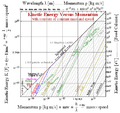Planck time facts for kids
The Planck time is the shortest possible length of time that can be measured. It's so incredibly tiny that we can't measure anything smaller than it. Think of it as the "smallest tick" on the universe's clock!
This idea comes from Werner Heisenberg's uncertainty principle. This principle says that you can't know everything about a tiny particle at the same time with perfect accuracy. Because of this, there's a limit to how precisely we can measure things like time.
The Planck time is about 0.00000000000000000000000000000000000000000001 seconds (that's 10−44 seconds!). To give you an idea, the smallest time ever actually measured by scientists is a "zeptosecond," which is 10−21 seconds. That's still much, much bigger than the Planck time.
One Planck time is how long it would take a tiny particle of light, called a photon, to travel a distance equal to one Planck length. The Planck length is the smallest possible distance.
Contents
What is Planck Time?
Planck time is a special unit of time. It's part of a system of measurements called Planck units. These units are based on fundamental constants of nature. These constants include the speed of light, the gravitational constant, and the Planck constant.
Who Discovered It?
The idea of the Planck constant was first thought of by a German physicist named Max Planck in 1900. He was studying how energy is transferred in tiny packets, or "quanta."
Planck found that the energy of a light particle (a photon) is linked to its frequency. He used a special number, now called the Planck constant, to show this connection. This constant helps us understand how energy works at a very small scale.
Why Can't We Measure Smaller?
Another physicist, Max Born, helped improve Heisenberg's ideas. Born showed that when you try to measure things like a particle's position and its momentum (how much it's moving) at the same time, there's always a tiny bit of uncertainty.
This uncertainty is related to Planck's constant. It means that we can never know both things perfectly. Just like we can't perfectly pinpoint a particle's exact location and speed at the same time, we also can't perfectly pinpoint an exact moment in time beyond the Planck time. It's the ultimate limit for measuring time.
Related pages
Images for kids


